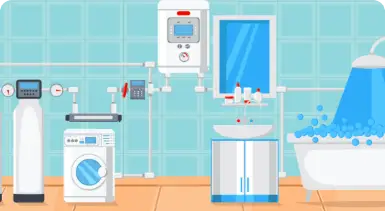Air to water source heat pumps
- These systems extract heat from the air using an evaporator coil. An air source heat pump looks rather like an air conditioning unit and are fixed on an outside wall of the building
- using mains electricity, the heat pump boosts the heat from the air to the level needed by the heating system, heating water in a buffer tank
- the heating system is then fed from the buffer tank.
Air to air heat pumps extract the heat from outside, boost it to the required level, and blow out hot air into a room, or through vents around the building. They can also be used for cooling (air conditioning).
Advantages
- reduce your carbon footprint
- reduce energy bills
- heat your home and water
- some financial return
Heat pumps aren’t suitable for every home. Heat pumps are designed to heat the water needed to heat your home to a lower temperature than traditional boilers. As a result, the ideal place for them is an extremely well insulated house with underfloor heating, as this provides a greater surface area than a traditional radiator. You can use a heat pump with radiators, but to get the same level of heat you will need larger radiators. Many older buildings are not energy efficient enough to use underfloor heating or low temperature radiators. Heat pumps can be cost effective in places where there is no mains gas supply. Heat pumps can replace gas or electricity heating.
Air source heat pumps take up much less space than ground source, but you do need a bit of distance between the pump and your neighbour. Because they do not take up much space, air source heat pumps can be used in flats and in urban areas, although the visual impact of this needs to be taken into consideration.
The performance of a heat pump is rated as a seasonal performance factor (SPF). It is the total useful heat generated from the heat pump in a year divided by the annual electricity consumption. For example, an SPF of 3 indicates that the system will give an average three units of heat energy for each one unit of electricity used.
To be considered ‘renewable’ (under EU legislation) heat pumps must have a SPF of at least 2.5, and this is the minimum performance that is eligible for the Domestic Renewable Heat Incentive.
All heat pumps should be serviced every few years.
Heat pumps are expected to last for over 20 years
Air source heat pumps typically cost between £9,000 and £11,000, as reported by Energy Saving Trust in 2020.
There are running costs to factor in as well. Heat pumps use electricity to run so your electricity bill will increase (although other energy costs eg on oil, will be saved). The heat output will be more than the electricity input. Where heat pumps are wrongly sized or incorrectly used you may end up paying too much for your electricity, so watch out for this.
Air source heat pumps are classed as permitted development as long as they meet a long list of criteria. You should contact your local planning department to check conditions will be met.
Renewable Heat Incentive
Air source heat pumps (air to water) are eligible for the Renewable heat Incentive.
You should use an MCS certified installer to install your system. This means that the installer should adhere to technical standards of installation and you can benefit from financial incentives like the RHI.






